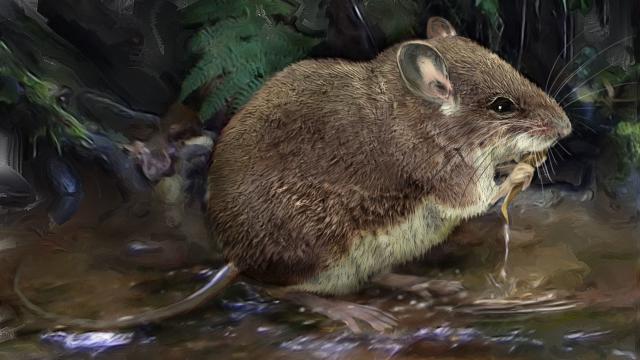African rainforests are home to some of the most delightful and surprising species on Earth, as demonstrated by recent research into some rather unusual water-loving rodents.
A study published today in the Zoological Journal of the Linnean Society describes two species of semi-aquatic mice. Living in the Congo Basin and the western parts of equatorial Africa, these mice make a living by hunting insects and tadpoles while wading through shallow water.
The authors of the new study, led by biologist Tom Giarla from Siena College in New York, did a deep dive into an enigmatic genus of mouse known as Colomys, which translates to “stilt mouse” on account of their elongated feet.
Two of Giarla’s collaborators on the project, Terry Demos and Julian Kerbis Peterhans from the Field Museum in Chicago, had been doing field work in Africa for decades, and they told him about a rather odd species of rodent they had been catching near streams and swamps in central Africa — a rodent known as Colomys goslingi.
“Based on limited previous research, it purportedly had an enormous range, with scattered collecting records extending from Liberia all the way to Kenya and south to Angola,” explained Giarla in an email. “Immediately, we suspected that this one species might actually comprise several species, because few tropical rodents have such a wide natural range.”

To get a better handle on Colomys, the scientists took a look at the relevant field work, collected physical specimens from museum collections, and took samples of DNA. The comparative analysis resulted in the identification of four distinct species belonging to Colomys, two previously known and two unknown to science.
One of the known species, C. eisentrauti, was elevated from a subspecies to a full-blown species of its own, and its habitat was defined as being restricted to northwest Cameroon. The other known species, C. goslingi, was found to have a more restricted range than previously thought. The two newly described species were named C. lumumbai and C. wologizi, in honour of Congolese independence leader Patrice Lumumba and Liberia’s Wologizi Mountains.
The authors also took this opportunity to study a strange mouse specimen found in Ethiopia back in 1927. This creature was previously assigned to an entirely new genus and species, Nilopegamys plumbeus, and it’s probably extinct. The lone specimen exhibited characteristics similar to those seen on the stilt mice, such as water-resistant fur and elongated feet, but scientists hadn’t been able to figure out where it fit within the evolutionary family tree of rodents.
“Thanks to the curators at the Field Museum, where the only specimen is housed, we got permission to sample a piece of dried tissue stuck to its skull,” said Giarla. “I managed to extract DNA from that bit of very old, dried tissue and sequenced some of its DNA. I had to do all of this work in a special laboratory space to ensure no other DNA could contaminate it. When I built the evolutionary tree for all of our Colomys and Nilopegamys samples, it was clear that Nilopegamys was closely related to Colomys.”
In fact, so closely related that the two groups are now considered sister genera.
Colomys are mice, but you’d never mistake them for the kind hiding within your walls. They’re larger than house mice, with thick brown fur, long whiskers, bright white bellies, and elongated feet that can only be described as kangaroo-like. They also have unusually big brains, which may have something to do with their semi-aquatic lifestyles.
“Their skull volumes are huge relative to other African rodents,” explained Giarla. “We think this is to support the mechanosensory system associated with their long whiskers, which they use to hunt aquatic animals like insect larvae and tadpoles. As far as I know, no other rodent hunts like Colomys — they walk through shallow water on their long feet with their whiskers draped over the surface of the water, waiting to pounce on anything that moves,” he said, adding: “They are oddballs.”
Stilt mice are primarily found in shallow streams, but they’ve also been spotted in swampy areas and the shallow edges of deep rivers. They’re also nocturnal, spending their nights foraging for food along shallow streams in dense forests, a task made possible by their kangaroo-like feet. Beyond this, they’re somewhat of a mystery.
“I’d love to know more about the behaviour and ecology of these animals,” said Giarla.
In addition, he’d like to include Colomys in some broader comparative studies to get a better handle on the evolutionary processes that give rise to new species in tropical Africa. Giarla would also like to find evidence of Nilopegamys, but he fears the animal is truly extinct.
Which brings up an interesting point having to do with conservation.
Giarla said the new study was motivated by his interest in mapping the spread and evolutionary histories of small mammals living in the forests of equatorial Africa, such as rodents, opossums, and shrews — animals that don’t get a lot of attention.
“The forests of West Africa, the Congo Basin, and the East African rift system are facing big threats from human activities, such as deforestation and mining,” he said. “Some species with small ranges will likely go extinct soon if more of the forest isn’t protected.”
